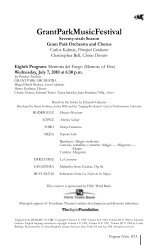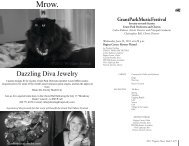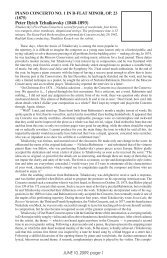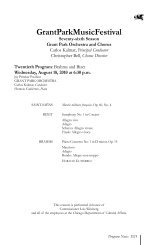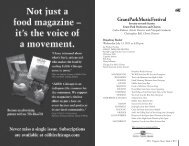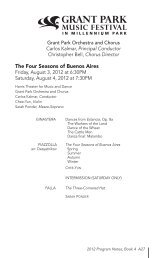rossini's Stabat Mater - The Grant Park Music Festival
rossini's Stabat Mater - The Grant Park Music Festival
rossini's Stabat Mater - The Grant Park Music Festival
Create successful ePaper yourself
Turn your PDF publications into a flip-book with our unique Google optimized e-Paper software.
Friday, July 20 and Saturday, July 21, 2012<br />
Aguardo in April 1842. <strong>The</strong> work was adapted for use in Rossini’s funeral service at La<br />
Trinité on November 21, 1868, and heard again when his remains were reburied among<br />
those of other heroes of Italian culture at Santa Croce in Florence in May 1887.<br />
Rossini’s <strong>Stabat</strong> <strong>Mater</strong>, though based on a text which limbs the sorrows of the<br />
mother of Christ, encompasses a wide range of emotions in its ten movements, from<br />
stern tragedy to hopeful expectancy. Like Verdi’s Requiem, the <strong>Stabat</strong> <strong>Mater</strong> has been<br />
accused of borrowing too much of the theater to wrap the ancient liturgical words,<br />
though Rossini preferred to think of the music’s long melodic arches and undeniable<br />
drama not as sacrilege but as opera’s offering to the Church. Indeed, in the last four<br />
movements — those which he added in 1841 — Rossini anticipated the brilliance and<br />
emotional weight of the most ambitious passages in Verdi’s Requiem (whose initial<br />
inspiration was, perhaps not coincidentally, Rossini’s death). This intensity of expression<br />
is really quite extraordinary, since Rossini was not overtly religious, though he never fully<br />
outgrew the cultural foundation of Catholic tradition in which he had been raised. When<br />
the priest at his last rites asked the obligatory question about his beliefs, the dying<br />
composer responded, “Would I have been able to compose the <strong>Stabat</strong> <strong>Mater</strong> and the<br />
Petite Messe solennelle if I had not had faith?” From the quiet introspection of its two a<br />
cappella movements to the titanic wailings of its closing fugal Amen, the <strong>Stabat</strong> <strong>Mater</strong><br />
is one of the greatest documents of sacred music of 19th-century Romanticism.<br />
Introduction (Chorus and Soloists)<br />
<strong>Stabat</strong> <strong>Mater</strong> dolorosa<br />
<strong>The</strong> sorrowful Mother stood<br />
juxta crucem lacrimosa<br />
weeping by the cross<br />
dum pendebat Filius.<br />
where her Son was hanging.<br />
Aria (Tenor)<br />
Cujus animam gementem,<br />
Her spirit cried out,<br />
contristatam et dolentem,<br />
full of anguish and sorrow,<br />
pertransivit gladius.<br />
as if pierced by a sword.<br />
O quam tristis et afflicta<br />
o how sad and distressed<br />
fuit illa benedicta<br />
was that blessed Woman,<br />
<strong>Mater</strong> unigeniti!<br />
Mother of the only-begotten Son!<br />
Quae maerebat et dolebat<br />
How She grieved and suffered<br />
et tremebat cum videbat<br />
and trembled as She saw<br />
nati poenas inclyti.<br />
the agonies of her Son.<br />
Duet (Soprano, Mezzo-Soprano)<br />
Quis est homo qui non fleret<br />
What man would not weep<br />
Christi Matrem si videret<br />
to see the Mother of Christ<br />
in tanto supplicio?<br />
in such torment?<br />
Quis non posset contristari<br />
Who would not be saddened<br />
piam matrem contemplari<br />
seeing the pious Mother<br />
dolentem cum Filio?<br />
grieving for her Son?<br />
Aria (Bass)<br />
Pro peccatis suae gentis<br />
For the sins of the world,<br />
vidit Jesum in tormentis,<br />
She saw Jesus in torment<br />
et flagellis subditum.<br />
and beaten down with whips.<br />
Vidit suum dulcem natum<br />
She saw her sweet Son<br />
moriendo, desolatum,<br />
dying in desolation,<br />
dum emisit spiritum.<br />
giving up His spirit.<br />
2012 Program Notes, Book 3 A39



